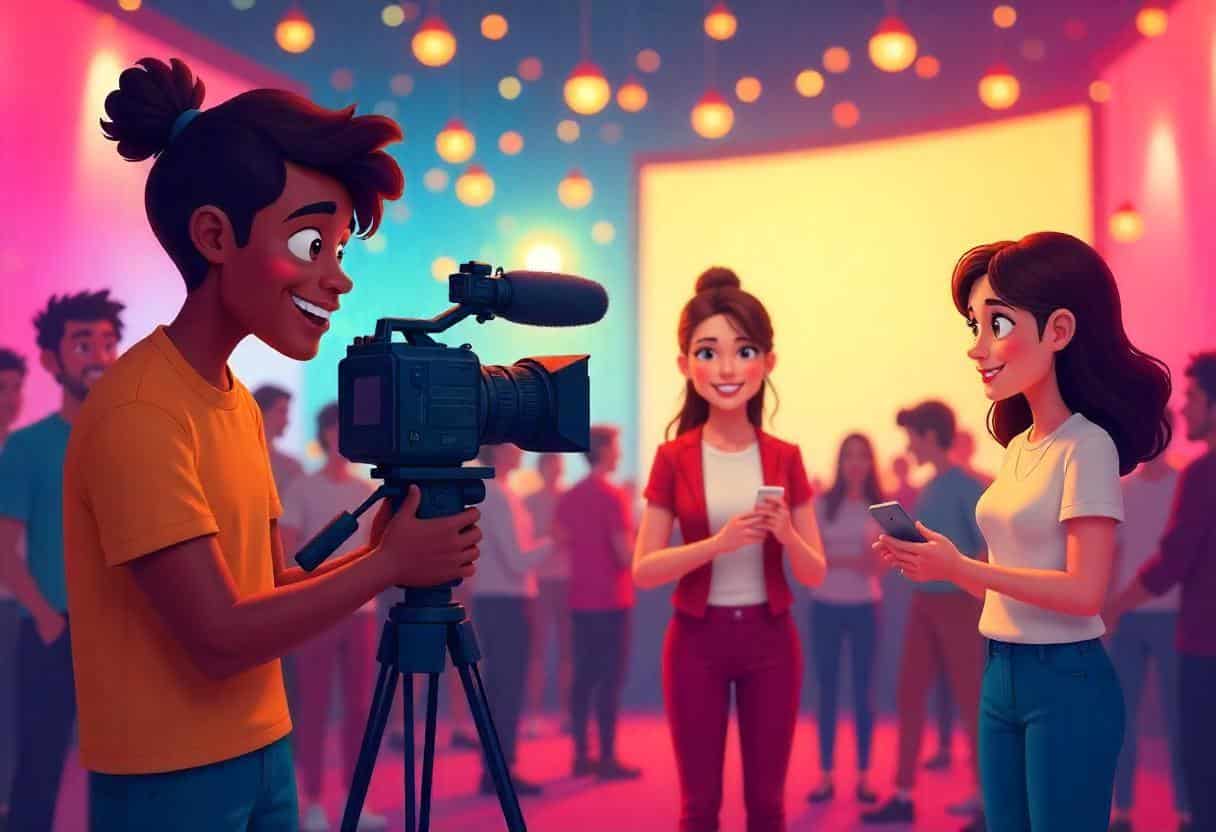90% nonsense, 10% genius.
That’s what your first draft looks like.
You sit down, pen in hand, and think- This is it, my Pixar moment.
Then- SFX: Rising orchestra.
Welcome to animation scriptwriting.
Here, the texts don’t just focus on stories. They also focus on what moves, breathes, speaks, and makes sounds– on screen.
Most animated scripts go through multiple rewrites before making it to the storyboard. At least dozens of rounds of drafts. [Source: Coverfly]
That’s why if your script were a video file, it’d be called “final_final_final_revised_v2_v3_approved.mov”
Reason? Scripts can go wrong. This includes irregular pacing, flat jokes, and mismatched visual dialogues.
Hence, you need some animation scriptwriting tips to avoid that. Like-
- Aligning concepts with your target group
- Infusing humor or emotional depth
- Keeping the visuals and voices natural
- Timing your gags
- Not overcrowding scenes
- Always reading it out loud
That’s a formula for crafting powerful stories and earning millions of views from people.
The Core of An Animation Script
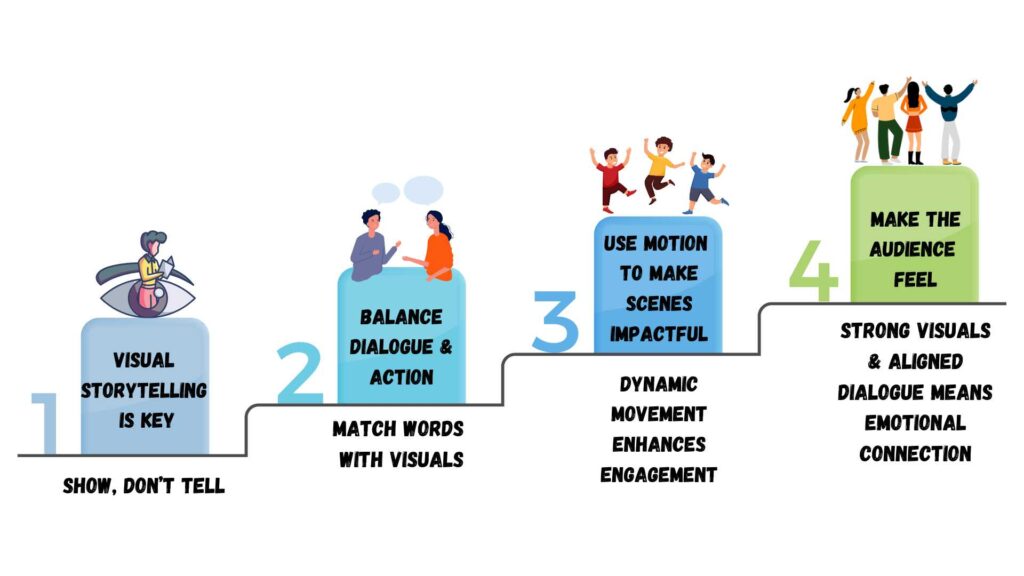
Visual Storytelling in Animation
When it’s animation, “show, don’t tell” is the golden rule.
You may have watched Wall-E. Half the story goes without words.
The visuals can say a lot more than just a dialogue. You want your viewers to EXPERIENCE the story.
For example,
- Timmy felt scared in the dark. How about we SHOW Timmy’s big eyes, his shaky hands, and the shadows creeping around him?
That way, the audience feels his emotions right alongside him. This will make the moment more impactful.
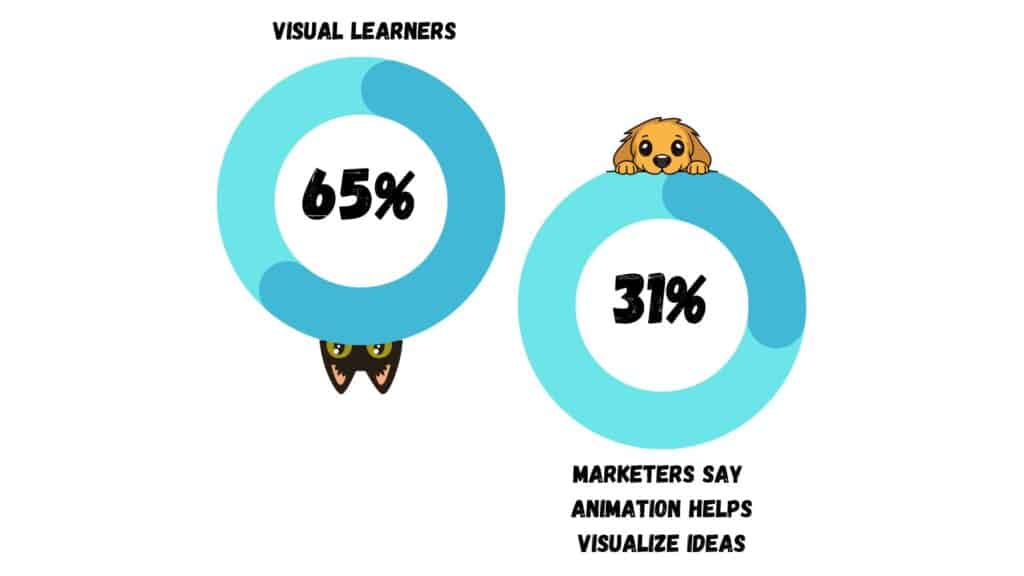
Moreover, Stats mention that,
“65% of the people are visual learners.”
So, make the most of that behavior.
Even 31% of the marketers say animation helps them better visualize concepts.
Plus, we have the advantage of movement in the animated world. You can make the scene more dynamic through graphic elements. This makes visual learning effective.
Like- if you just say,
“It was raining and he was running.” This seems dull. But if you ANIMATE it and show the rain splashing around, the character struggling to run, or maybe slipping- now that’s engaging.
Balance Between Dialogue and Action
When you’re writing for animation, focus on balance.
You want the character’s word to match what they’re doing. Like, if a character is happy, let the dialogue reflect that.
It should have both words and lively actions.
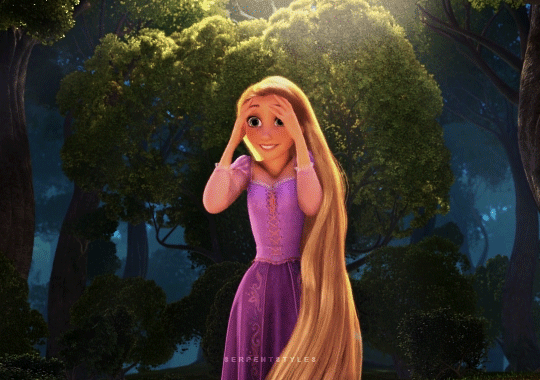
[Gif Source: Tangled]
See how Rapunzel is happy about finally seeing the world after being confined to a tower her entire life?
Animators have shown her ecstasy through jumping around, spinning, and then shouting, “I can’t believe I did this”.
Such a combo brings the vibe to life.
Remember, show the emotions while aligning them with words, movements, and graphics. This interaction draws viewers in like a magnet.
How to Develop the Story and Characters?
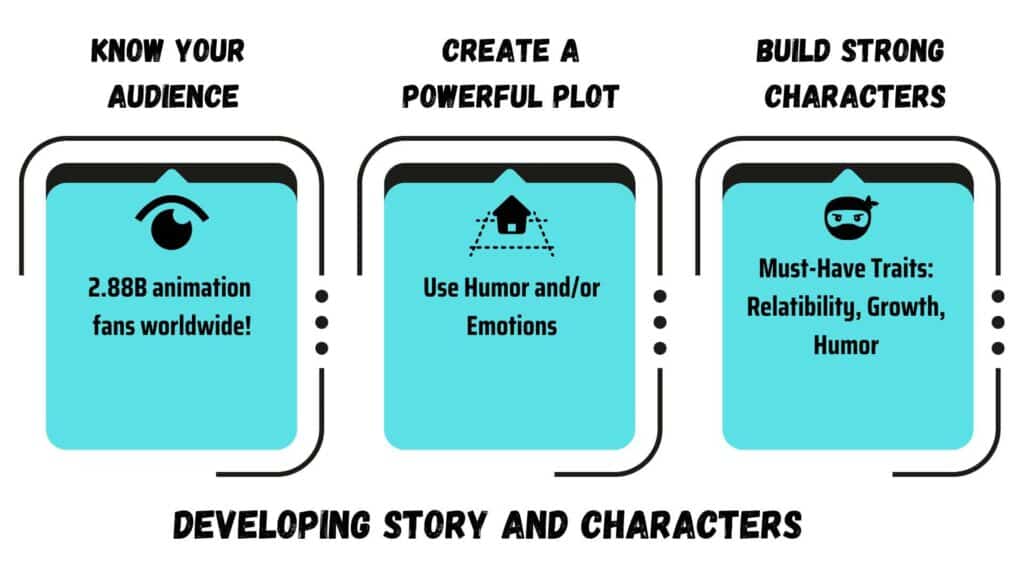
Identify Your Target Audience
Know who you’re talking to.
Get insights into the demographics. This includes the age, gender, interests, and professions of your audience. That way, you can tailor content with engaging stories based on the people.
This can help you grab their attention more efficiently.
One good news is that-
A big wedge of viewers is into animation. At least 2.88 billion worldwide!
Although people of all ages love toons, most are younger internet users.
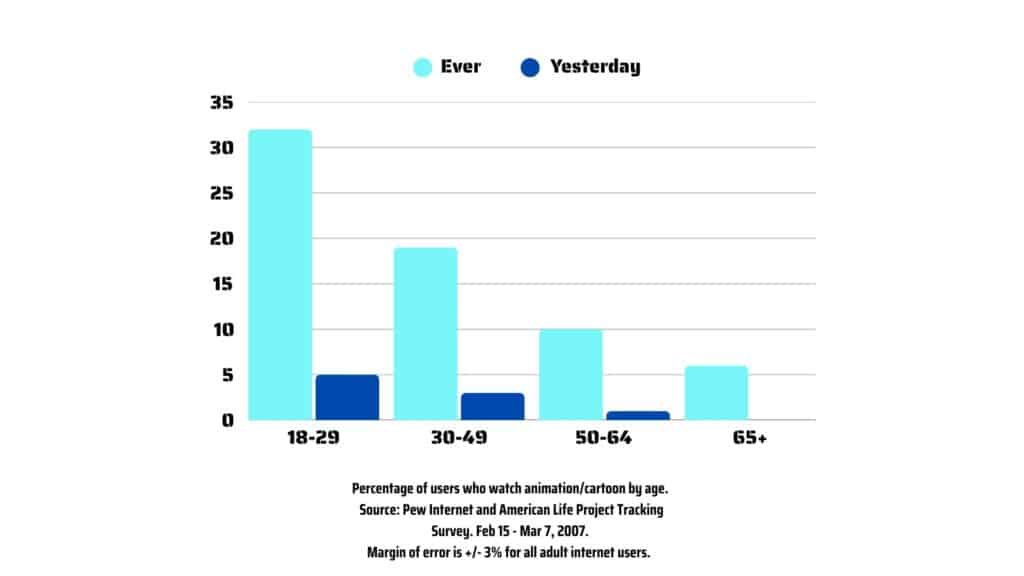
As per the Pew Research stats,
“32% of 18 to 29-year-olds, 19% of 30 to 49-year-olds, and 10% of 50-year-olds say they watch animated content online.”
So, you have a big chunk of your potential customers.
You just have to line up your vision and concept with the audience.
Let’s take some ideas from the table-
| Audience | Animation Style | Notes For Scriptwriting |
| Kids (6-12) | 2D and 3D, Cartoon | Bright and simple animation. Add humor, action, and imaginative scenes. Fun, simple dialogue. |
| Teenagers | Anime, Stylized 2D, and 3D | Emotional depth, character development, and relatable teen problems. |
| Young Adults (20-35) | Mixed media, motion graphics, and Anime | Add humor, sarcasm, and modern themes. Focus on clarity and emotional storytelling |
| Adults (36+) | 3D, Realistic, Minimalistic, Explainer | Concise and direct. Add humor, sarcasm, and modern themes. |
| Corporate Pros | Whiteboard, motion graphics, Flat animation | Use a professional tone, clear structure, and informative content |
| Gamers or Tech Savvy | 3D, CGI, Stylized | Add immersive storytelling and dynamic pacing. |
Note that the table is just to give you an idea. You can mix and match.
Craft Compelling Plots
Come up with plots that click.
Focus on emotions that your viewers can connect with. It can be ecstatic, sad, suspenseful, or adventurous.
Adding them to your storytelling helps engage the audience better.
Narratives play an important role in animation. Studies say that “it engages key brain parts, including areas that help you think and remember.”
For this, viewers naturally remember stories better than plain facts or data.
Moreover, a solid way to guide your story is the “Three-Act Structure”. It’s like a blueprint for your narrative. And it’s super helpful.

Here’s a quick breakdown.
Setup: This is where you introduce the main characters and set the stage. Hook your audience within the first 10 seconds.
Confrontation: Now, here’s where the drama starts. The main conflict appears. This helps drive the story forward and makes the animation more engaging.
Resolution: The conflict is resolved, and the characters may have learned something valuable in the end.
Such a structure makes it easier to map out your plot and keep viewers hooked.
You can try different storytelling techniques like-
- The Hero’s Journey Framework
- Conflict and Resolution
- Character-Driven Narratives
- Time-Lapse and Chronology
- Interactive
Character Arcs and Development
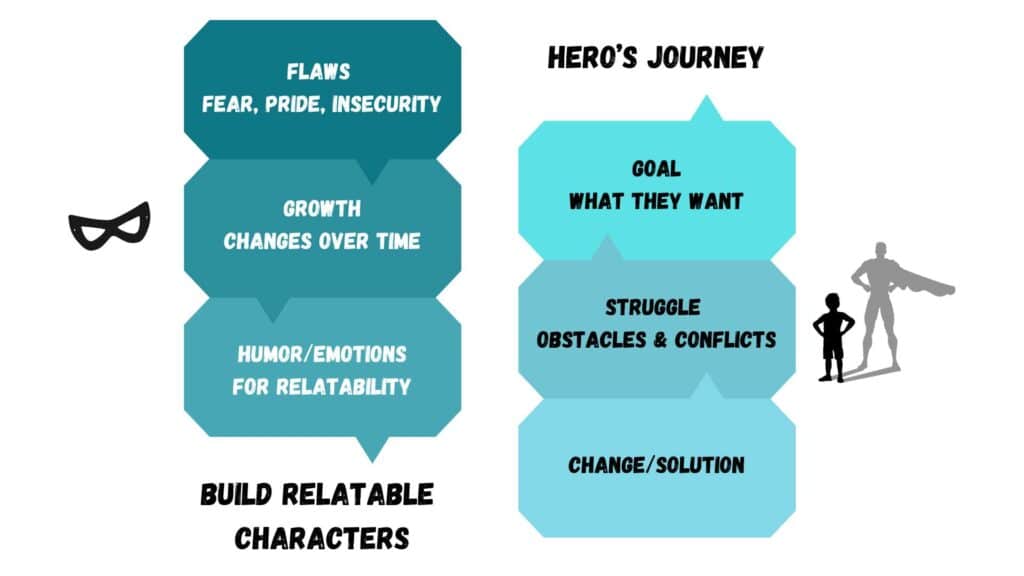
Your characters are the stars of the show. So, try to build a strong character.
It doesn’t mean physically powerful. It’s more about the role. This will help motivate your audience.
Highlight how the character grows and changes as the story progresses. It’s because flat characters are boring. The most efficient way is the Hero’s Adventure Framework.
The hero will have aspirations, face obstacles, and evolve through their journey.
Let’s take Elsa from Frozen.
- She starts off feeling trapped and isolated because of her powers. However, as the story unfolds, she learns to embrace her identity and feels confident.
That journey of self-discovery can resonate with your viewers, especially the ones who feel out of place.
It’s because most of us go through similar experiences. So, there’s a relatability factor.
Some tips:
- Give your character a flaw- fear, pride, or laziness to make them more relatable.
- Most loved animated characters have 3 traits: Relatability, growth, and humor. Use them.
How To Create Engaging Dialogue?
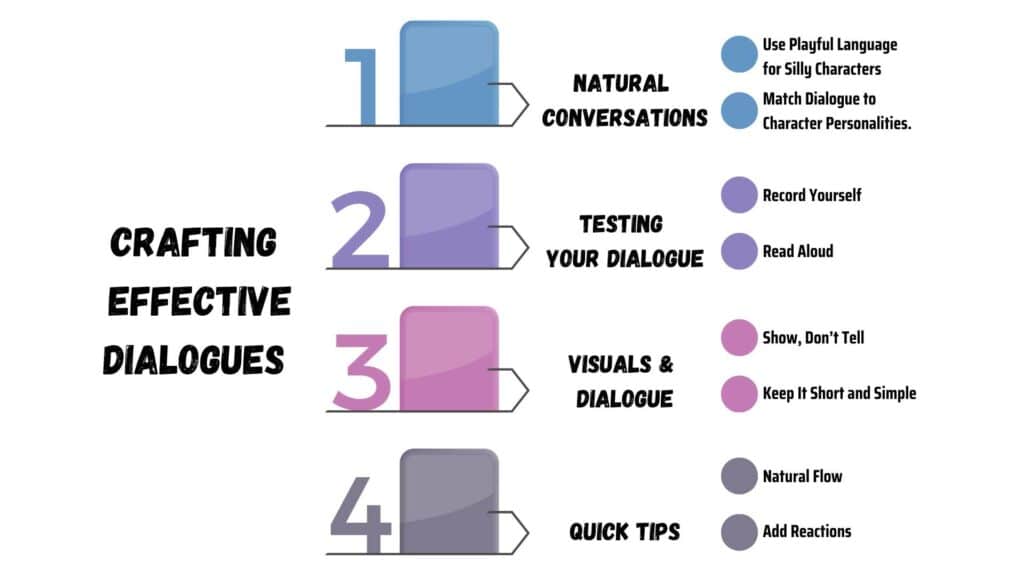
Natural and Playful Conversations
Keep it fun and natural.
Your characters need to sound like real people. Each character should have their own voice. It’s more effective if you use the unique voices of real people for the animated characters.
Also, when writing dialogues, consider their backgrounds and personalities. That way, you can align them well.
For example-
- Silly character? Use playful language and make jokes.
- Serious? Try to make your character talk more straightforwardly.
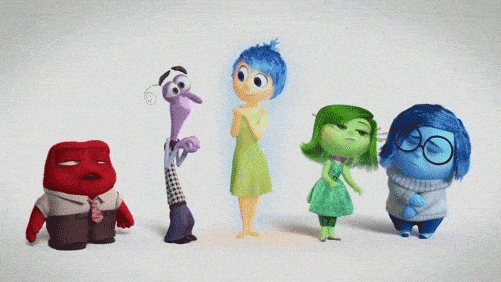
[Gif Source: Inside Out]
Speaking of personality, it should be unique, just like the characters in Inside Out. This brings more energy to the animation.
How to test dialogue?
- Record yourself speaking the lines
- Ask a 10-year-old if they understand (if it’s for kids)
- Read the lines out loud. Feels weird? Rewrite it.
- Kids’ dialogue should be simple and fun.
Try to add humor depending on the concept. A well-placed joke or funny grip lightens the mood and makes people laugh.
Just remember to keep it natural. If it sounds forced, it may throw off the vibe.
Complementing Visuals with Dialogue
Don’t say what you can show.
In animation scriptwriting, balancing visuals and dialogue is a must. Visuals show the action, and dialogue adds emotions.
Good scripts use short, clear dialogue that matches the action on screen. This teamwork between what we see and hear keeps the audience interested.
Ensure they talk like real people.
Use words to reveal emotions or personality, not just explain the scene. If there’s an intense moment, the dialogue has to boost the energy.
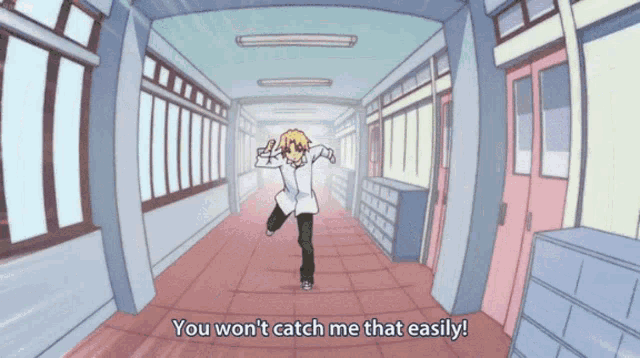
[Gif Source: Place to Place Anime]
Bad example: Look, I’m running.
Good example: Show the characters running while they say, “You can’t catch me”.
This kind of interactive dialogue amps up the excitement and keeps your viewers glued to the screen.
Always ask: Can the visuals tell this part alone? If yes, use fewer words.
Dialogue should enhance, not repeat the visuals.
Remember:
- Avoid stiff or formal words. Keep it flowing naturally, just like how we talk.
- Add jokes or fun moments. A little humor makes it playful and fun to watch.
- Use short, snappy sentences. Keep the dialogue quick and clear.
- Use pauses and reactions. Let them react with uh-oh, huh, really?- to make it feel real.
How To Integrate Visual Elements?

You have your story and the character.
Now, it’s time to put those scenes on paper.
Descriptive scene directions are essential. They help animators know-
- What the scene looks like
- Where the characters are and
- What they are doing
Besides, they set the mood and tone.
For the settings, use clear words that exactly describe the scene or situation.
- Mention whether it’s day or night.
- Highlight the weather- is it sunny, snowy, or monsoon?
- Add details like trees, buildings, or furniture and how they appear.
But don’t go overboard! Keep it brief yet vibrant.
| Instead of saying | Try something like |
| The forest was dark and had many creepy trees. | The dark forest looms with shadows stretching from gnarled trees. |
It paints a picture without going into too much detail.
Next, the character actions.
Say what they are doing and feeling. For example-
- She’s sad. She looks down and wipes her eyes.
Animators need to see movement. Keep actions clear and short.
Formatting Your Animated Script
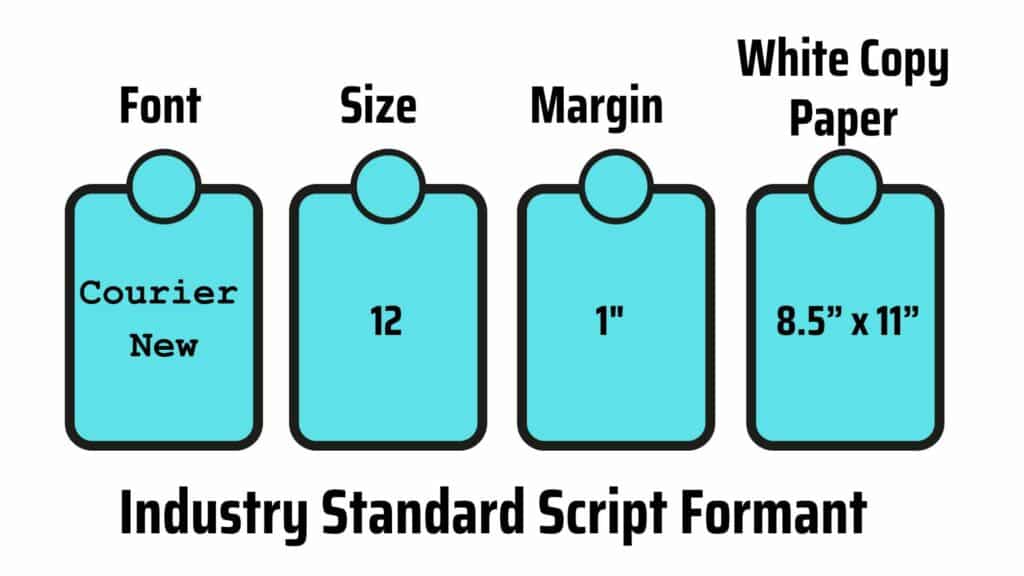
Industry Standards
Let’s talk about how to make your animation script look neat and professional.
Proper formatting is the key.
Use the industry standard. It helps everyone understand your script’s flow and structure.
- Font: Courier New
- Size: 12 Point
- Margin: 1 inch
- 8.5” x 11” white copy paper
- Example Scene Heading: INT. HOUSE – Day (Interior, location, time)
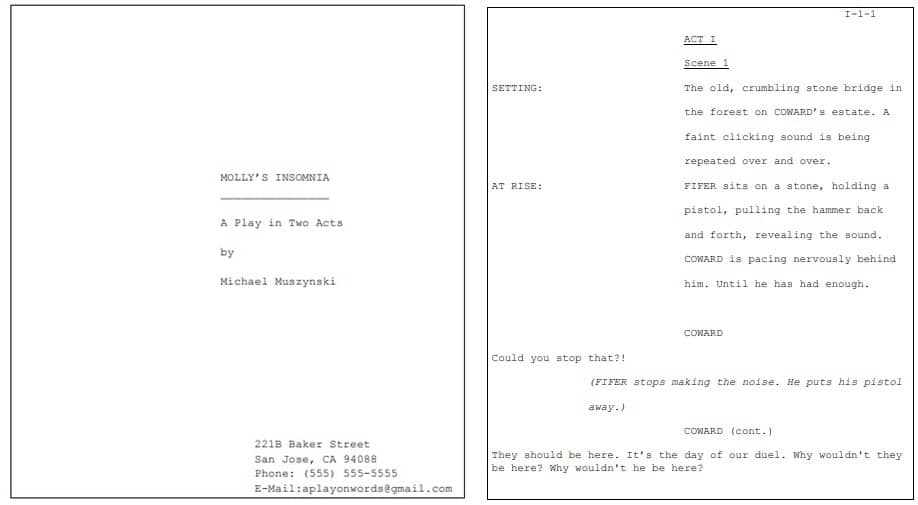
Why does it matter?
A good rule of thumb is that one page of a script equals about one minute of screen time. This gives directors and animators an idea of your piece’s length.
A well-formatted script should look sharp. It makes your work easier for everyone involved, be it animators or voice actors.
Animation-Specific Format
For animation, the scripts often include visuals and sound design.
Animators mostly use storyboards for the job. It’s a graphic rendition of sequential panels or frames.
The board features a series of ordered drawings and breaks down the action into individual panels. You can add elements here, like-
- Frames for key scenes
- Scene description
- Characters
- Objects
- Dialogue
- Timing
- Background
- Transition
- Sound and music
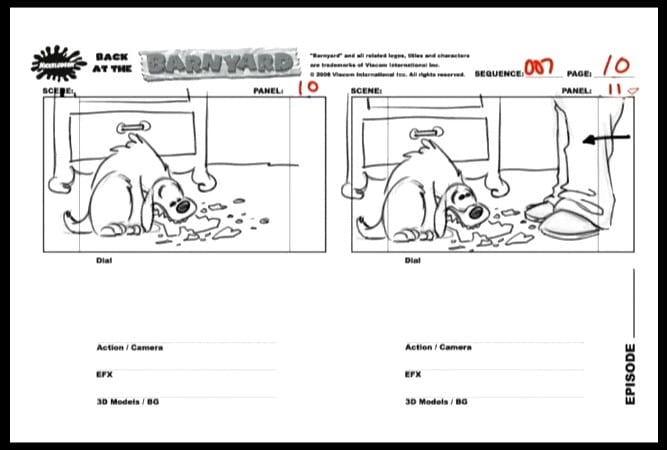
[Source: Youtube]
For example,
- VFX: The sky turns dark purple
- SFX: Boom! The door slams shut
A storyboard is a super useful tool for animation.
You visualize better how scenes will look with it. Moreover, the tool helps you spot issues or make changes early in the process.
Don’t forget to note the timing for:
- Scene change
- Character actions
- Transitions
Common Mistakes to Avoid
| Pitfall | Aftermath | Solutions |
| Over-describing scenes | Slows down the narrative. Confuses everyone. | Keep the description short, clear, and simple. Focus on key visuals. Scenes should be vivid. |
| Flat character development | Dull narratives. Lack of audience connection. | Create strong character arcs.Ensure character growth. |
| Ignoring audience interests | Stories may not resonateLost viewer interest. | Know the target audience.Tailor content to their interest. |
| Cliched dialogues | Predictable plots. Unoriginal. | Aim for uniqueness.Infuse fresh and relatable dialogues. |
| Weak pacing | The story feels disjointed | Balance action and dialogue.Read the script out loud. |
| Lack of visual cues | Animators may misinterpret scenes | Include clear scene directions and sound cues for clarity. |
Tips for Polishing Your Script
Revise and Seek Feedback
- Write at least 3 drafts
- Ask others to read the script- fresh eyes catch mistakes
Reach out to the Best Feedback Sources
- Other writers: for plot holes
- Animators: for visual clarity
- Common people like friends or coworkers: for errors
- Target audience: for engagement
Read Aloud
- If a line sounds weird when spoken, change it.
- It helps catch awkward phrasing
- It helps improve rhythm and pacing
Resources and Tools for Animation Writers
Software Recommendation
Final Draft
Used by pros. Includes tools for scene structure and notes.
Celtx
Great for beginners. Offers templates and collaborations.
WriterDuet
Cloud-based. Good for working with teams.
Trelby
Free and open source. Simple interface.
Educational Materials
Books
- Animation Writing and Development by Jean Ann Wright
- Story: Style, Structure, Substance, and the Principles of Screenwriting by Robert McKee
- Save The Cat! The Last Book on Screenwriting
Courses
Script Writing for Animation (PDF)
Frequently Asked Questions
How do you write an engaging animation script?
Start with a strong concept. Develop relatable characters. Create compelling plots. Incorporate humor, conflict, and visual storytelling. This helps make the animation script engaging.
How many pages is a 30-minute animation script?
One page per minute is the rule used in screenwriting. So, a 30-minute animation script is 30 pages long.
How to make a good storyline for your animation?
Focus on a clear premise. Build a strong conflict. Ensure character development. This makes a good storyline for animation.
What makes a good animation script?
Unique concepts, well-defined characters, humor or emotional depth, clear dialogue, and visuals. These elements make a good animation script.
How do I break down a script for animation?
Read it multiple times. Identify key elements like characters, locations, and props. Then, organize this information into a structured breakdown sheet or template. Focus on visual and narrative elements.

Founder at LocalEyes Video Production | Inc. 5000 CEO | Emmy Award Winning Producer




